
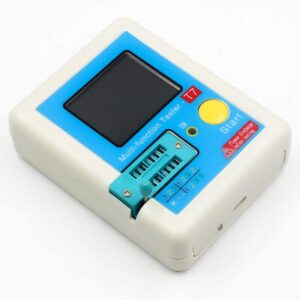

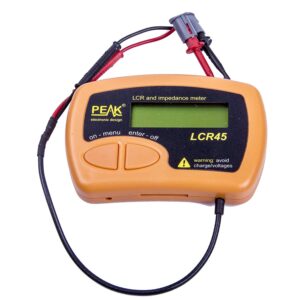
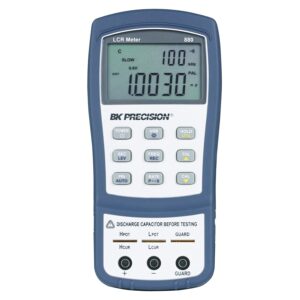
Customer’s Choice: the Best Rated LCR Meters
[survey_answers id=”707981792″ style=”plain” data=”score”] users answered this survey. Please help us improve this review!
[survey_answers id=”707981792″ style=”piechart” legend=”true”]
LCR meters are designed to calculate the parameters of simple passive electronic components. It measures such features as capacitance (C), resistance (R) and inductance (L). LCR meters are available in portable/handheld and benchtop versions.
Handheld meters are generally picked for portability, field usage and even for hobbyists to provide a low-cost option of minimal precision.
LCR meters come with a big, bright screen to help you to interpret accurate values. Some include a data keep role that helps you to maintain and write unique readouts. Other features to be anticipated from these devices involve USB help, auto power-off, and a low battery indicator.
Why buy an LCR meter?
You need an LCR meter to calculate critical electrical values such as power, inductance and resistance. While other instruments can do this selectively, the LCR meter is more precise, user-friendly and analytical. It also offers you ease of voltage and current measurement.
The greatest problem for most LCR meter buyers is to find the right choice. We get this, and that’s why the review was compiled to find the best LCR meters, a buying guide, and a comparison chart. Take advantage of this comprehensive tutorial.
Proster LCR Meter LCR Multimeter Tester– the best for beginners!
 Are you looking to buy an easy, budget-friendly LCR meter to calculate power inductance? Then try this Proster LCR meter. It boasts a liquid crystal display for easier reading and receives a high degree of precision.
Are you looking to buy an easy, budget-friendly LCR meter to calculate power inductance? Then try this Proster LCR meter. It boasts a liquid crystal display for easier reading and receives a high degree of precision.
The meter is often user-friendly and can be used to measure tiny capacitors and inductors. The Proster LCR Meter arrives with a test probe, a 1.9V charger, a crocodile clip, a handbag, a screwdriver, and a manual.
The Proster LCR meter was also designed with basic functionality. It has an auto power-off feature and a low power indicator. That way, you’re not going to be shocked when your instrument unexpectedly runs out of battery.
Pros
- Bright and adjustable LCD (also rotates);
- Affordable;
- Has a portable bag;
- Many features;
Cons
- Lacks voltage overload protection;
- Flimsy;
The meter is simple to use and it can be applied to instruct the consumer when the battery is down. It arrives with the double integral and A/D conversion method for improved measuring.
ICQUANZX LCR-T7 Transistor Tester– the best for self-calibration!
 The ICQUANZX LCR-T7 tester was designed to detect infrared waveforms and the Zener Diode is self-calibrated. The data code and the infrared waveform will be shown when the detector is decoded successfully.
The ICQUANZX LCR-T7 tester was designed to detect infrared waveforms and the Zener Diode is self-calibrated. The data code and the infrared waveform will be shown when the detector is decoded successfully.
Thanks to a single-key process, the detector can be identified and shut down immediately, and you can click the multi-function key to shut the detector. It is also robust and simple to use.
With the tester, you may determine the component values in a very short time. That helps with work and saves time.
Pros
- Good performance;
- Easy to use;
- Self-calibration;
- Informative readings;
- Portable;
Cons
- The display shuts down too quickly;
- Instructions could be more detailed;
- Small screen;
This device could be great for testing parts before welding, simple to use, very reliable for a hobbyist, or much more sophisticated well worth purchasing.
LCR-T4 (Aitrip) Mega328 Digital Transistor Tester– the best for the test speed!
 The LCR-T4 Mega328 tester will detect the resistor, the MOSFET safety diode amplification coefficient and the baseline for deciding the forward partial voltage emitter transistor.
The LCR-T4 Mega328 tester will detect the resistor, the MOSFET safety diode amplification coefficient and the baseline for deciding the forward partial voltage emitter transistor.
It has an adaptive shutdown feature that can prevent excessive wasting, conserve battery resources and increase battery life.
It is accurate when calculating the precision parts. This item comes in a box with no directions.
Pros
- A single button launch;
- Automatic shutdown;
- Includes the case;
- Good for testing the speed;
Cons
- Doesn’t include battery;
- The contrast can’t be adjusted;
It is a quite convenient LCR meter. But keep in mind that it requires a bit of zooming in on the images to get it in the shell, but you should leave the battery attachment hanging externally just in case it kills the battery in standby.
PEAK Atlas LCR45 LCR and Impedance Meter – the best for resolution!
 The LCR45 can be a perfect enhancement to the famous LCR40. Bring a finer measuring precision of 0.2uH, 0.2pF and 0.2 Ohm and sophisticated mathematical research to your workshop gear. It’s really quick to use-simply clip the standard test leads to your part and click the test button.
The LCR45 can be a perfect enhancement to the famous LCR40. Bring a finer measuring precision of 0.2uH, 0.2pF and 0.2 Ohm and sophisticated mathematical research to your workshop gear. It’s really quick to use-simply clip the standard test leads to your part and click the test button.
Readings are carried out constantly, offering you the perfect method to make fine changes. You may choose the automated and manual modes for both the part form and the test frequency.
Its sophisticated modules have rich calculation capabilities. The Peak Atlas meter continues reading and shows it constantly for improved performance.
Pros
- Hold function is convenient;
- The accurate frequency measurement;
- Advanced components;
Cons
- Digits may blacken out;
In addition, this LCR meter may also help to define the parameters of the variable, its acceptability and its magnitude. It fits auto and manual modes, and the consumer can select one as per requirement and help a better test pace.
B&K Precision 880 100 kHz Handheld LCR Meter– the best for accuracy!
 The handheld B&K Precision 880 100 kHz meter provides features usually seen only in bench LCR meters such as 4-terminal setup, simple measurement accuracy up to 0.1 percent, test frequency up to 100 kHz, configurable test signal levels and calibration rate.
The handheld B&K Precision 880 100 kHz meter provides features usually seen only in bench LCR meters such as 4-terminal setup, simple measurement accuracy up to 0.1 percent, test frequency up to 100 kHz, configurable test signal levels and calibration rate.
The B&L device has the main monitor that can display a resolution of 40,000 counts and a secondary panel that makes a resolution of 10,000 counts.
It is ideal for primary measurements of L, C, R and Z. The LCR meter makes a higher sensitivity of up to 0.1 percent.
This LCR meter is smartly built for fast calculation and simple part measurement.
Pros
- Good controls and interface;
- Powerful display;
- Fast;
- Accurate;
Cons
- Quite expensive;
The B&K Precision LCR is a portable meter that is simple to bring and fitted with an electric auto range for fast and reliable measuring results.
The Buyer’s Guide
Handheld or benchtop?
While some benchtop LCR meters offer more functions, they are not compact. If you’re a mobile technician, you require a portable/handheld LCR meter to carry it effortlessly.
Automatic or manual?
There might be two forms of automated and manual LCR meter. An electronic LCR meter determines the value automatically, while the manual LCR meter allows the consumer to set the value manually.
You should choose this according to your requirements. Auto LCR meter is the perfect LCR meter for better calculation.
In comparison to the manual LCR meter, the electronic LCR meter adjusts automatically. It is therefore quicker and more accurate in terms of performance.
Major parameters:
- Inductance measures the tendency to resist the flow changes in electric current;
- Resistance measures the flow’s opposition in the electric current;
- Capacitance measures the device’s ability to accumulate and store an electrical charge;
Besides these major specs, some LCR meters can measure current and voltage.
Durability
Durability is important if you need your LCR meter to last a long time. Often, make sure that the meter maintains high efficiency in order to find more accurate data.
Whenever you operate with a handheld device, and particularly if the batteries are concerned, it’s necessary to take a moment to think about durability. Since people want to leave things off. What occurs when the LCR meter falls to strong cement? Are there any grips on the tool to further minimize the risks of this happening? That’s why the build quality has to be solid.
Accuracy
A precise and consistent meter is what you’re searching for. Have one that can return precise findings at a higher frequency.
Precision for LCR meters is all about deciding between analog and automated. Analog components appear to be inexpensive, but digital components appear to be much more reliable.
Electricians could use an LCR meter to measure frequencies between 100 and 10,000 Hz. For some forms of applications, methods that work with precision can be located within less than 1% of the variance. But if you don’t require precision, you can save a few bucks by utilizing a tool that is precise to a few hundred.
Mode and function
Many LCR meters provide two modes of calculation – Series and Parallel modes. Different modes are needed, since all real-world components have a parallel parasitic component in sequence, along with their meaning.
The series mode treats the device under evaluation as an analogous series circuit, while parallel mode considers the device as a parallel equivalent circuit. If the resistance of the part under test is strong, the equal resistance of the series is insignificant and thus the parallel mode is used. Alternatively, if the impedance is smaller, the parallel portion is marginal and the series mode is to be applied.
Additional information to be reviewed when choosing an LCR meter are the selection of test frequencies given and the level of the test signal. DC bias (Voltage/Current) is needed to control the component under conditions of practical usage of the component in the circuit.
Screen and display
The filter should be broad and transparent enough to enable users to read quickly. The screen decides the usability of the readings. You should get an LCR meter with a wide and brighter screen for simple and precise reading. You’re not going to force your eyes to see what’s projected on your screen. More to that, the show often has to be bright in order to be physically enticing.
Weight
Invest in a compact meter if you choose to carry it with you and a heavy-duty device if you’re going to use it in a fixed position.
Are you going to take the LCR meter to the office every so often? If indeed, suggest a lightweight build as it offers you portability advantages. A variety of handheld LCR meters are as accurate and fast as benchtop ones, and you can see samples in this list.
Data interface
Many of the better LCR meters would provide some sort of data storage aboard. Many gadgets come with built-in PC applications, but it’s not always simple to use, and it’s not always compliant with either form of operating system (OS).
Video Tutorial: Proster BM4070 LCR Meter Review
Final thoughts
Hopefully, this buyer’s guide has provided you a good vision of what you’re searching for in the LCR meter and the reviews have been useful, and now you’re able to pick the right one for yourself.

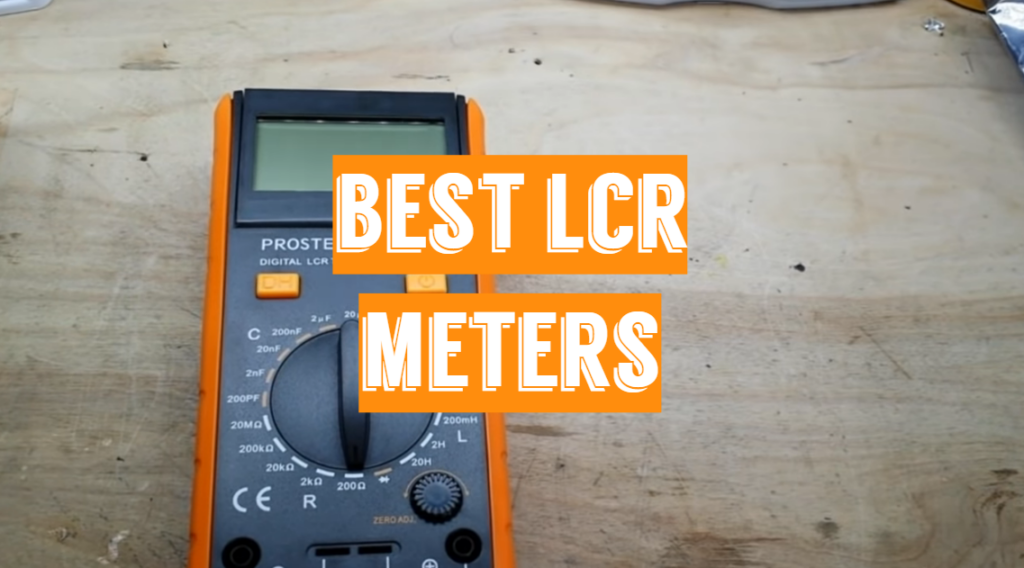

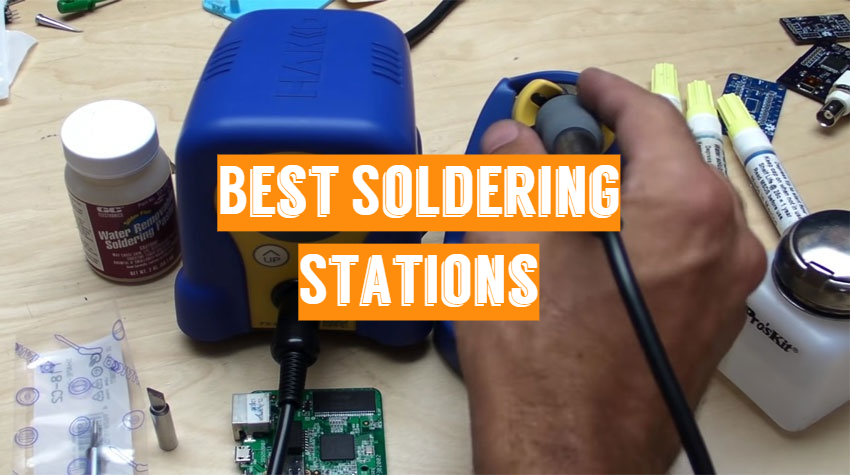
I compared LCR-TC1 with LCR-T7 and concluded that both radios are similar in design and performance.
The Atmega324PA is present in the TC1 and 7H. I’ve looked through both of them, and the Zener ratings are identical. The area where Zener diodes may be detected ranges from 0.01 to 30 volts. It’s possible that there was a typing error in the description for the 7H.